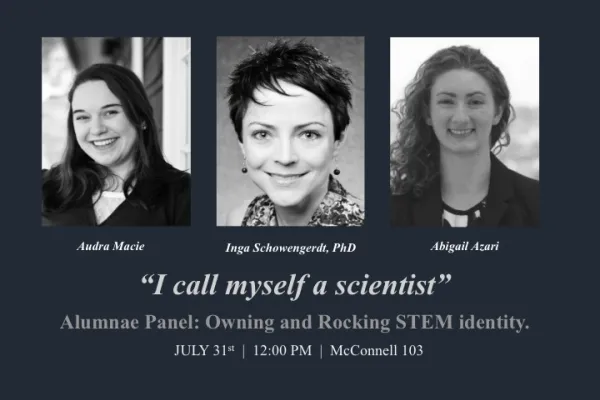Sharing ‘Aha’ Moments: Alumnae Chart Their Paths as Scientists
Research & Inquiry

Published August 4, 2015
If someone had told Inga Schowengerdt ’02 when she first came to Smith that she was destined to become a scientist, “I wouldn’t have believed them,” she said.
“I was not convinced I could be good at science,” said Schowengerdt, who recently completed a master’s degree and a Ph.D. in social and developmental psychology at the University of Cambridge in England. “I came to Smith thinking about STEM mainly as something I had to do to get into college.”
But after taking psychology courses at Smith and working on projects with faculty mentors, Schowengerdt got “hooked” on scientific research.
“I learned that psychology is an awesome tool with broad applications,” she said. “I realized there was a field that I wanted to be part of—and lo and behold, it was a science.”
Schowengerdt was one of three alumnae who shared their paths to becoming scientists at a recent panel discussion on campus. She was joined by two members of the class of 2013: Audra Macie, now an engineer at Raytheon Integrated Defense Systems in Woburn, Mass., and Abigail Azari, who will be starting graduate studies this fall at the University of Michigan as a NASA Earth and Space Science Fellow.
The aim of the “I Call Myself a Scientist” panel was to inspire students to do just that, said Valerie Joseph, mentoring program coordinator for Smith’s Clark Science Center, which sponsored the July 31 event.
I have a sense of the challenges you encounter as a woman scientist. And I have more of a sense of why I want to continue on to graduate school.
Joseph noted that because women are still underrepresented in STEM fields, it is often difficult for them to identify as scientists. “When we think of scientists, we still picture a guy in a lab coat,” she said. “We asked panelists to share with us how they got to the point of seeing themselves as scientists.”
For Macie, that journey required perseverance. She came to Smith planning to study chemistry, then switched to physics after taking a first-year seminar with associate professor Gary Felder.
In her introductory physics courses, Macie quipped that she “felt like an imposter” compared to classmates who seemed to absorb the lessons more quickly.
“But I was stubborn,” she said. “I kept at it and got into upper-level physics courses and then something clicked.”
The “sense of satisfaction” Macie got from doing science flourished when she began working as an engineer at Raytheon soon after graduating from Smith.
“Having that work experience has given me insight,” Macie told Smith summer research fellows and faculty members attending the panel. “I have a sense of the challenges you encounter as a woman scientist. And I have more of a sense of why I want to continue on to graduate school.”
Azari said developing her identity as a scientist meant thinking more broadly about how to use her skills and training. After graduating from Smith with a degree in physics, she worked as a science policy fellow for the Institute for Defense Analyses’ Science and Technology Policy Institute in Washington, D.C.
“It wasn’t what I’d studied for—going from physics to policy was a bit of a switch,” said Azari, who provided policy analyses to federal agencies on urgent topics such as climate change, STEM education and space exploration.
Her experience in Washington helped propel her to the next step: pursuing a doctorate in space science. NASA, through the Earth and Space Sciences Fellowship, is funding part of Azari’s graduate studies beginning this fall at the University of Michigan’s Atmospheric, Oceanic and Space Sciences program.
Schowengerdt’s “aha moment” came when, after years of avoiding quantitative work, she realized she needed to master statistics and data analysis in order to be an effective researcher.
“There were lots of long nights and lots of tears, but I realized this was part of being a scientist,” Schowengerdt said. “I also realized that science is more like sports, where you have to practice to get better. Struggle is not a sign of limitation; it’s a sign of learning.”
Since graduating from Smith, Schowengerdt has conducted research on vital gender-gap issues, including increasing the representation of girls and women in STEM. This fall, she will teach social psychology to inmates at two prisons in eastern Massachusetts as an instructor in Boston University’s Prison Education Program.
Discovering that STEM fields could be “altruistic” was what helped Schowengerdt to see herself as a scientist. “When I got to work on a project I really cared about—designing a curriculum for middle-school girls—that’s when I started to appreciate my identity,” she said.
During a question-and-answer session with the audience, panelists offered advice for launching careers in STEM. Suggestions ranged from citing research projects on résumés, to keeping in touch with faculty mentors, to using resources available through Smith’s Lazarus Center for Career Development—including suits that can be borrowed for job interviews.
Azari urged students to “own” scientific successes they’ve had in the classroom—and on the job.
“Unless you own what you’ve done, you won’t be given those kinds of assignments again,” she said.
Macie emphasized that while she’s seen discrimination in her field, “I’ve also seen ways around it.”
“There are lots of great mentors out there,” Macie said. “Don’t let anyone tell you that you can’t do science—because you can!”